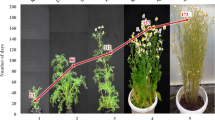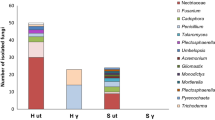Abstract
BEDDOWS1 has raised some interesting points regarding Triodia decumbens, particularly as regards the occurrence of ‘cleistogenes’ at the base of the fertile tillers in the cleistogamous form. Subsequent investigation of their structure has shown that these ‘cleistogenes’ may contain as many as three florets. Structures are present within their enveloping prophyll which possibly represent empty glumes; these, however, are by no means consistent either as to form or presence. The fertile florets, on the other hand, have well-developed flowering glume and palea. The three minute bi-sporangiate anthers are intrastigmatic. ‘Cleistogenes’ may ripen as many as two healthy caryopses, which have been found germinating in situ.
This is a preview of subscription content, access via your institution
Access options
Subscribe to this journal
Receive 51 print issues and online access
$199.00 per year
only $3.90 per issue
Buy this article
- Purchase on Springer Link
- Instant access to full article PDF
Prices may be subject to local taxes which are calculated during checkout
Similar content being viewed by others
References
Beddows, A. R., "Triodia decumbens, Beauv. (Sieglingia decumbens, Bernh.)", Ann. Bot., 15; 1931.
Weatherwax, P., "Cleistogamy in Two Species of Danthonia", Bot. Gaz., 85; 1928.
Author information
Authors and Affiliations
Rights and permissions
About this article
Cite this article
POULTER, A. Occurrence of ‘Cleistogenes’ in certain Grasses. Nature 129, 690–691 (1932). https://doi.org/10.1038/129690d0
Issue Date:
DOI: https://doi.org/10.1038/129690d0
This article is cited by
-
Cleistogamic flowers
The Botanical Review (1938)
Comments
By submitting a comment you agree to abide by our Terms and Community Guidelines. If you find something abusive or that does not comply with our terms or guidelines please flag it as inappropriate.



